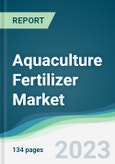The aquaculture fertilizer market is projected to grow at a CAGR of 7.21% to reach US$30.147 million in 2028 from US$18.53 million in 2021.
Aquaculture fertilizers are specifically designed to promote the growth of algae, plankton, and other natural food sources in aquaculture systems, providing essential nutrients for farmed aquatic organisms. These fertilizers also improve water quality, promote growth, and prevent diseases. Common examples of aquaculture fertilizers include urea, triple superphosphate, potash, sodium nitrate, and ammonium polyphosphate.The aquaculture fertilizer market is primarily driven by the increasing demand for aquaculture products, rising awareness about the importance of balanced nutrition in aquaculture systems, and the need for sustainable aquaculture practices. Additionally, the growing emphasis on reducing the dependence on wild-caught fish and promoting responsible aquaculture methods further fuels the demand for aquaculture fertilizers. Moreover, the ever-increasing demand for seaweed and algae is also propelling the growth of aquaculture fertilizers, as they are essential for the growth and development of algae and seaweed plants. According to UNCTAD data, in 2019, 34.7 million tonnes of seaweed was produced via farming. Between 1950 and 2019, the world's seaweed cultivation rose thousand times.
However, challenges such as the availability of quality fertilizers, environmental concerns associated with excessive fertilizer use, and stringent regulatory norms pose potential restraints to market growth. Using fertilizers in aquaculture can have ecological implications if not managed properly. Excessive application or improper handling of fertilizers can lead to nutrient runoff, causing eutrophication in water bodies. Eutrophication, characterized by excessive algae growth, can deplete oxygen levels, harm aquatic ecosystems, and lead to water quality degradation.
The growing demand for aquaculture products is supporting the global aquaculture fertilizer market growth.
Aquaculture, also known as fish farming, has become an essential part of the global food industry due to the increasing demand for seafood. However, maintaining optimal water quality and providing adequate nutrition for farmed aquatic organisms pose significant challenges. Aquaculture fertilizers play a crucial role in addressing these challenges by promoting the growth of natural food sources, such as algae and plankton, which serve as the primary feed for farmed fish, shrimp, and other aquatic species. According to the latest report by FAO on aquaculture, a record 214 million tonnes of aquaculture products were produced in 2020, including 178 million tonnes of aquatic animals and 36 million tonnes of algae.Aquaculture farmers strive to enhance productivity and optimize yields to meet the growing demand for seafood. Fertilizers help create favorable conditions for the growth of natural food sources, such as algae and plankton, which serve as the primary feed for farmed aquatic organisms. By improving water quality and nutrient availability, aquaculture fertilizers contribute to increased productivity and healthier growth of aquaculture species. According to the latest FAO report on aquaculture, the per capita consumption of aquaculture products reached a record high of 20.2 kg in 2020. Aquatic food consumption is anticipated to rise by 15 percent by 2030, reaching an average of 21.4 kilograms per person due to rising incomes, urbanization, better post-harvest procedures, and dietary patterns.
North America is anticipated to hold a significant share of the global aquaculture fertilizer market.
North American region will experience rapid expansion throughout the projection period due to the growing demand for aquaculture products. This region's market is also expanding due to the increasing emphasis on sustainable aquaculture practices. According to the official data, Fish and seafood exports from Canada reached an all-time high of CA$8.79B in 2021, up 36 percent from the previous year. The number of exports was 613 thousand tonnes, an 8 percent rise from 2020. According to UNCTAD data, the North American region produced 23,385 tonnes of seaweed in 2019. Moreover, the presence of a well-established agriculture and aquaculture industry and increasing investment are also spurring regional demand for aquaculture fertilizer. In addition, the prevalence of key market players such as FMC Corporation, Yara International ASA, Mosaic Company, and others also spur the growth of aquaculture fertilizer in this region.Market Developments:
- In March 2023, the Food and Agriculture Organisation of the United Nations in Sri Lanka delivered 36,000 tonnes of Triple Super Phosphate fertilizer to the Ministry of Agriculture for immediate distribution to all farmers throughout the nation thanks to funding from the United States Agency for International Development.
- In April 2022, Agrimin signed a legally binding offtake agreement with Gavilon Fertiliser, LLC, for the supply of 50 000 tpy of sulfate of potash (SOP) generated from the Mackay Potash Project for sale and distribution in the US.
Market Segmentation:
By Source
- Urea
- Superphosphate
- Potassium Chloride
- Others
By Application
- Seawater Aquaculture
- Onshore Aquaculture
By Geography
- North America
- United States
- Canada
- Mexico
- South America
- Brazil
- Argentina
- Others
- Europe
- United Kingdom
- Germany
- France
- Spain
- Others
- Middle East and Africa
- Saudi Arabia
- UAE
- Israel
- Others
- Asia Pacific
- Japan
- China
- India
- South Korea
- Indonesia
- Thailand
- Others
Table of Contents
Companies Mentioned
- Sinofert Holdings Limited
- Luxi Chemical Group Co. Ltd.
- Yara International ASA
- Nutrien Limited
- The Mosaic Company
- OCP S.A.
- ICL Group Ltd. (Tel Aviv-Yafo, Israel)
- Koch Industries, Inc. (Kansas, U.S.)








